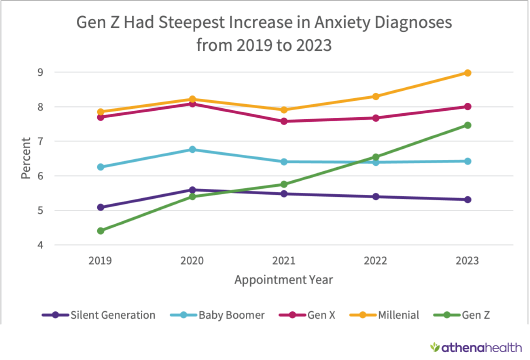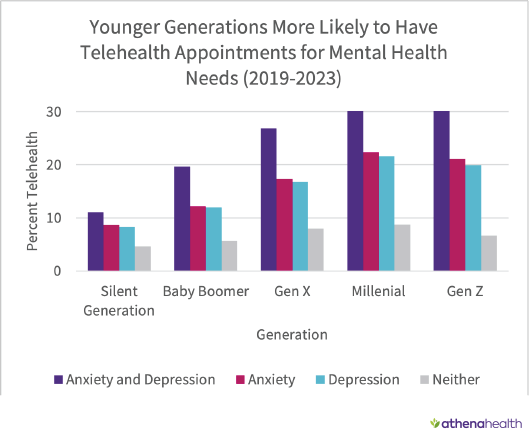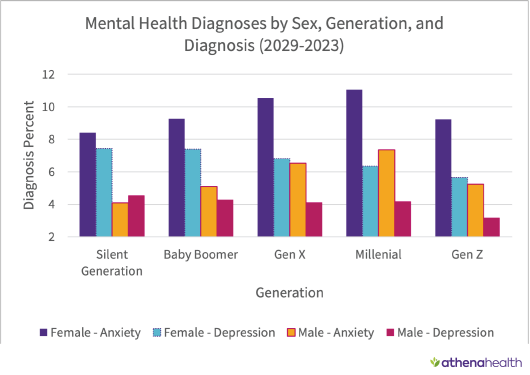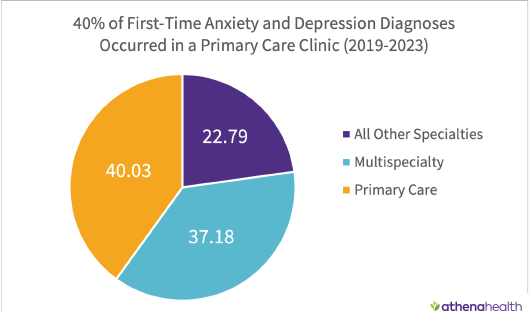America is in a mental health crisis, with an estimated one in five adults living with a mental illness. While a devastating statistic itself, the grouping of these individuals into a single data point makes it challenging to understand the full picture of these patients; who they are, where they are getting diagnosed, and how they are receiving treatment.
With over 150,000 clinicians and around one fourth of the US patient population on athenahealth’s network, we’re uniquely positioned to derive deep clinical insights on a variety of healthcare trends, including ones, like behavioral health, that show up in a variety of ambulatory care settings. Data provides detailed insights into the ongoing crisis, and information on who the individuals behind these statistics are, so clinicians can provide tailored care to their patients. To bring this level of insight to our partners, we looked at behavioral health trends specific to anxiety and depression from all athenaOne network appointments between 2019 and 2023.
As a board-certified pediatrician, I am not surprised by what we’re seeing in the research as well as hearing anecdotally. But I remain passionate about how healthcare technology and software can address, and in some instances, help alleviate these challenges, allowing clinicians to do more with less.
Generational differences: Gen Z and millennials are in crisis
We found younger generations – Gen Z and millennials - are the demographic struggling the most with their mental health compared to older generations – Gen X, Baby Boomers, and the Silent Generation. Our data showed that millennials are the most likely to have an anxiety diagnosis, but that Gen Z patients had the highest increase in diagnoses over these years. Specifically, in 2019, Gen Z patients had the lowest rate of diagnoses for anxiety – only 4.4%, but by 2023, anxiety diagnoses had risen to 7.5% for this demographic, a staggering 41% increase. Simultaneously, Gen Z also experienced a sizable increase (25.9%) in the percentage of patients receiving a depression diagnosis during this timeframe.

So, what can we do about this? First, it’s important to understand the ‘why’ behind these trends. For many Gen Z patients, this period of time represented a transitional period in their lives – many of these individuals left home and began college and experienced the COVID-19 pandemic during what was either their last years of high school or first years of college, adding additional stressors like online schooling and missed milestones (think graduation and proms). Additionally, for many in this age range, the pandemic likely represented one of the first negative life events that their parents could not shield them from.
Additionally, these generations have grown up with technology - and more specifically, in a society dominated by social media. There's no denying the mental health implications of unattainable standards, life comparisons, and the decline of face-to-face communication. In fact, research shows young people who spend more than three hours a day on social media face double the risk of mental health problems, including depression and anxiety. However, the upside to being tech savvy is the ability to use technology to better manage access to care through telehealth and through a variety of apps.
In fact, our data showed that these younger generations are far more likely than any other demographic to use telehealth for mental health appointments, ultimately suggesting the higher diagnosis trend may be double-sided: younger generations may be more anxious than their older counterparts, but they also may be better suited at looking for and accessing online care, which gives them more opportunities to be diagnosed by a physician.

Dr. Stanton Stebbins from Pediatrics Physicians, PC is noting similar observances within his practice, noting: “We are seeing more anxiety and depression among teens with concerns of lack of meaningful in-person social interactions, which are being replaced with technology, like social media. We're seeing an increase in patients coming to us for support, with the lack of mental health providers, and those that take insurance.”
What gender differences show
In addition to generational differences, the findings also revealed gender differences related to mental health diagnoses. Specifically, female patients were more likely than males to receive a diagnosis of either anxiety or depression across all age demographics. Overall, the gender gaps for depression were smaller than those for anxiety, but females still had higher percentages of diagnoses for all age groups.

The findings also showed females were more likely to receive a diagnosis of both anxiety and depression . Research shows that women generally have more interactions with and connections to the healthcare system than men. Additionally, data finds mental health in males often goes untreated, as they’re less likely to seek treatment than females. As women’s health continues to be in the spotlight, change is underway with women looking for new approaches to care and clinicians finding effective ways to deliver it, including with behavioral health. At athenahealth, we’re continuing to recognize this shift and have more on the evolution in our recent article here.
Bridging gaps in care with technology
Along with the mental health crisis across demographics, 49% of Americans live in a geographic area with a shortage of mental health clinicians, bringing an additional outside challenge into the equation. Staffing shortages continue to plague the industry as widespread burnout impacts providers, including 93% of physicians who participated in athenahealth’s third Physician Sentiment Survey stating they feel burned out on a regular basis – check out more here on the survey data.
While telehealth has become synonymous with the pandemic, it’s time for the industry to take those learnings and implement for continued success. In fact, we’re already seeing telehealth play a major role when it comes to behavioral health. The athenaOne data showed that telehealth continues to be commonly used for appointments where an anxiety or depression diagnosis was documented. While this was the case across all demographics, millennials (31%) and Gen Z (30%) had the highest rate of anxiety and depression diagnoses made via telehealth.
Telehealth removes access barriers for patients, allowing more patients to receive convenient and high-quality care. With the ability to access care from anywhere, patients have more flexibility, including not having to travel to and from appointments, reducing cost and time associated with in-person visits. Telehealth appointments are ideally suited to mental health visits as these types of visits can often be conducted without a physical exam. Furthermore, telehealth appointments can aid in solving existing access challenges as they allow clinicians the flexibility to conduct appointments from anywhere and, since telehealth appointments are more likely to stay within the allotted time, more patients can be accommodated. The industry is continuing to see the growth of dedicated telehealth companies focused on behavioral health, which will provide patients with additional choice and is anticipated to best support demographics like millennials and Gen Zs already utilizing these types of care tools .
Leaning into coordinated care efforts
The challenge of patient access to behavioral health also presents an opportunity for more coordinated care, ensuring patients are both receiving a mental health diagnosis, and can access treatment. The athenaOne data revealed that across all generations receiving a first-time diagnosis, 40% occurred at a primary care or multispecialty practice, not a practice that specialized in behavioral health.

Integrating behavioral health in a primary care setting can improve accessibility to treatment for patients, while removing requirements for separate appointments or long wait times for appointments. This is true for both medical management as well as therapy – while primary care providers are well equipped to prescribe medications, it is well documented that optimal mental health management includes a multi-pronged approach that may include both medication and therapy. Integrating behavioral health allows primary care providers to consult with mental health professionals on patients who may not respond to treatment as expected without the need to refer the patient outside of the practice – it also allows behavioral health clinicians, PCPs and patients to work together to create successful care plans. Coordinated care can also help provide comprehensive services in a familiar setting for patients. Additionally, as providers work to transition to value-based care, integrating behavioral health care into primary care can positively influence the total cost of care.
Setting providers up for success
Harnessing our deep clinical network of data and clinicians, we’re continuing to listen and act on findings to simplify the complexities in healthcare for all. Whether it’s telehealth, coordinated care, or EHR workflows tailored specifically for clinicians needs, technology can set clinicians up for success when it comes to the behavioral health space. The mental health crisis isn’t going away overnight, but with the right tools, the industry can support clinicians and patients alike.












